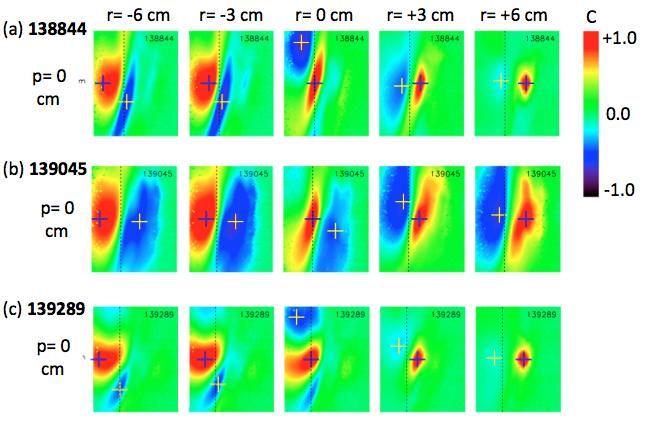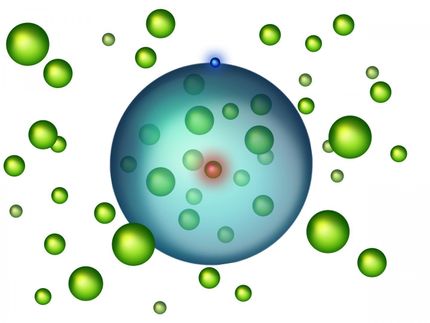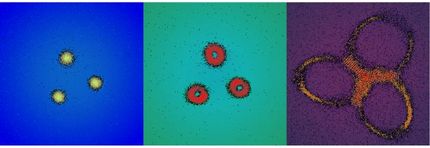A detailed look at 2-D structure of turbulence in tokamaks
A key hurdle for fusion researchers is understanding turbulence, the ripples and eddies that can cause the superhot plasma that fuels fusion reactions to leak heat and particles and keep fusion from taking place. Comprehending and reducing turbulence will facilitate the development of fusion as a safe, clean and abundant source of energy for generating electricity from power plants around the world.

Correlation analysis of three plasma discharges on NSTX for each of five different radial locations near the plasma edge. The red regions marked with a blue cross have high positive correlation around the origin point, while the blue regions marked with a yellow cross have high negative correlation.
Stewart Zweben
At the U.S. Department of Energy's (DOE) Princeton Plasma Physics Laboratory (PPPL), scientists have assembled a large database of detailed measurements of the two dimensional (2-D) structure of edge plasma turbulence made visible by a diagnostic technique known as gas puff imaging. The two dimensions, measured inside a fusion device called a tokamak, represent the radial and vertical structure of the turbulence.
Step toward fuller understanding
"This study is an incremental step toward a fuller understanding of turbulence," said physicist Stewart Zweben. "It could help us understand how turbulence functions as the main cause of leakage of plasma confinement."
Fusion occurs naturally in space, merging the light elements in plasma to release the energy that powers the sun and stars. On Earth, researchers create fusion in facilities like tokamaks, which control the hot plasma with magnetic fields. But turbulence frequently causes heat to leak from its magnetic confinement.
PPPL scientists have now delved beyond previously published characterizations of turbulence and analyzed the data to focus on the 2-D spatial correlations within the turbulence. This correlation provides clues to the origin of the turbulent behavior that causes heat and particle leakage, and will serve as an additional basis for testing computer simulations of turbulence against empirical evidence.
Studying 20 discharges of plasma
The paper studied 20 discharges of plasma chosen as a representative sample of those created in PPPL's National Spherical Torus Experiment (NSTX) prior to its recent upgrade. In each of these discharges, a gas puff illuminated the turbulence near the edge of the plasma, where turbulence is of special interest. The puffs, a source of neutral atoms that glow in response to density changes within a well-defined region, allowed researchers to see fluctuations in the density of the turbulence. A fast camera recorded the resulting light at the rate of 400,000 frames per second over an image frame size of 64 pixels wide by 80 pixels high.
Zweben and co-authors performed computational analysis of the data from the camera, determining the correlations between different regions of the frames as the turbulent eddies moved through them. "We're observing the patterns of the spatial structure," Zweben said. "You can compare it to the structure of clouds drifting by. Some large clouds can be massed together or there can be a break with just plain sky."
Detailed view of turbulence
The correlations provide a detailed view of the nature of plasma turbulence. "Simple things about turbulence like its size and time scale have long been known," said PPPL physicist Daren Stotler, a coauthor of the paper. "These simulations take a deep dive into another level to look at how turbulence in one part of the plasma varies with respect to turbulence in another part."
In the resulting graphics, a blue cross indicates the point of focus for a calculation; the red and yellow areas around the cross are regions in which the turbulence is evolving similarly to the turbulence at the focal point. Farther away, researchers found regions in which the turbulence is changing opposite to the changes at the focal point. These farther-away regions are shown as shades of blue in the graphics, with the yellow cross indicating the point with the most negative correlation.
For example, if the red and yellow images were a region of high density turbulence, the blue images indicated low density. "The density increase must come from somewhere," said Zweben. "Maybe from the blue regions."
Going forward, knowledge of these correlations could be used to predict the behavior of turbulence in magnetically confined plasma. Success of the effort could deepen understanding of a fundamental cause of the loss of heat from fusion reactions.





























































